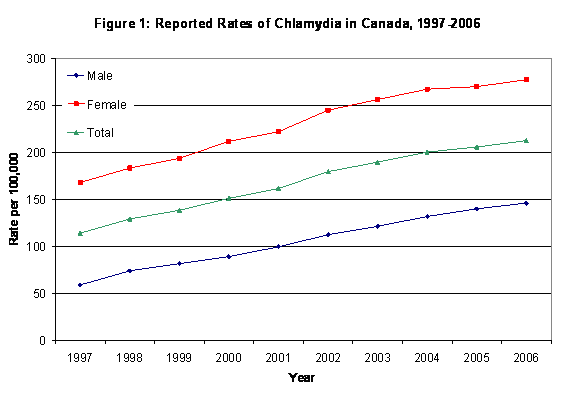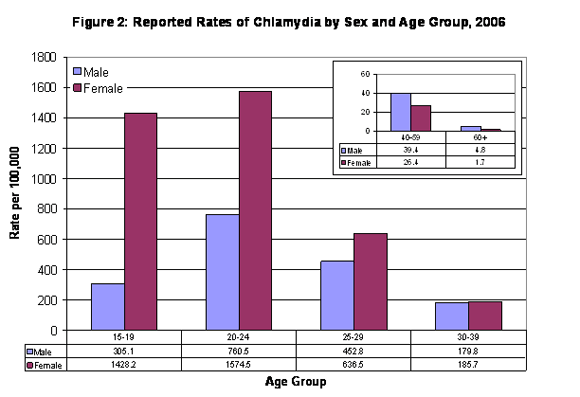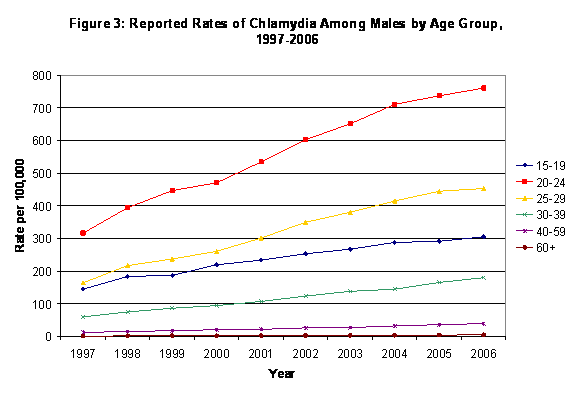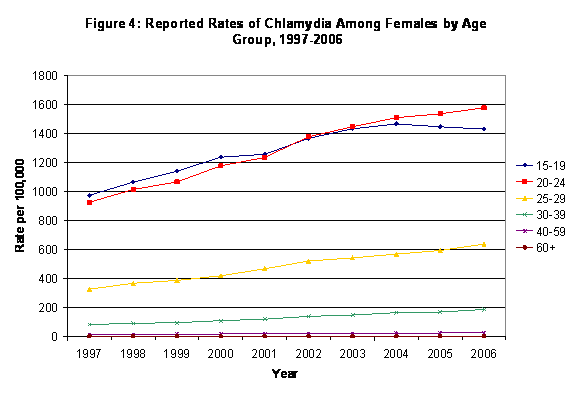Common menu bar links
Institutional links
Diseases & Conditions
Health & Safety
Research & Statistics
Agency Information
Search Box
E-mail this page
Brief Report on Sexually Transmitted Infections in Canada: 2006
Brief Report on Sexually Transmitted Infections in Canada: 2006
This overview summarises data collected through routine surveillance for three nationally notifiable sexually transmitted infections: chlamydia, gonorrhea, and syphilis. Several observations for 2006 are noteworthy.
Chlamydia (Chlamydia trachomatis)
Chlamydia trachomatis infections, nationally notifiable since 1990, are the most commonly reported sexually transmitted infection (STI) in Canada. C. trachomatis serovars D to K cause infection in the genital and anal regions. Serovars L1, L2 and L3 cause the infection lymphogranuloma venereum (LGV), which is not routinely reportable but is under enhanced surveillance. Refer to http://www.phac-aspc.gc.ca/publicat/lgv/index-eng.php for more information on LGV.
Because genital chlamydia disproportionately affects a younger population, particularly females, the consequences of untreated infection are of concern. Sequelae for women include pelvic inflammatory disease (PID), which can lead to chronic pelvic pain, ectopic pregnancy, and infertility. Pregnant women may transmit the infection to their infant, causing conjunctivitis or pneumonia. Less frequently, males develop epididymoorchitis or other less common conditions1 . Chlamydia can increase the concentration of cells in genital secretions that can serve as targets for HIV thereby increasing the risk of acquisition and/or transmission of HIV2
The reported rate of chlamydia infection is increasing in Canada, particularly among males.
- In 2006, 69,938 cases of chlamydia infection were reported, corresponding to a rate of 212.4 per 100,000 (Figure 1). The overall rate in 2006 increased by 3.3% from 2005 and by 86.4% since 1997.
- Between 1997 and 2006, reported rates of chlamydia infection in males increased by 148.6% (from 58.7 to 145.9 per 100,000) compared with a 65.3% increase in women during the same time period (167.8 to 277.3 per 100,000) (Figure 1).

Reported rates of chlamydia infection are highest among the younger population, particularly females.
- In 2006, the overall rate of reported chlamydia infections among women was 277.4 per 100,000, almost twice as high as the reported rate among men (145.9 per 100,000) (Figure 2).
- In 2006, the majority of reported chlamydia cases (82.8%) were in the under-30 age group (Figure 2). This is in contrast to gonorrhea and syphilis in which the same age group accounts for 65% and 20% of reported cases.
- Among women, the highest age-specific rate of reported chlamydia infections was among 20 to 24-year olds (1158.6 per 100,000) (Figure 2). While lower than the reported rate among females, the age-specific rate among males was also highest among the 20- to 24-year olds at 760.5 per 100,000 (Figure 2).
- The reported rate of chlamydia infection among males aged 60 and older was nearly threefold that of their female counterparts (4.8 vs. 1.7 per 100,000, respectively) (Figure 2).

Reported rates of chlamydia are increasing among older males.
- Between 1997 and 2006, the reported rate of chlamydia infection among males in the 60+ age group increased by 380.0% (from 1.0 to 4.8 per 100,000) (Figure 3).
- The largest increase in reported rates among females in that time period was in the 30 to 39-year age group at 126.7% (from 81.9 to 185.7 per 100,000) (Figure 4).


Reported rates of chlamydia infection are highest in the Northern Territories.
- Reported chlamydia rates continue to be highest in Nunavut, the Northwest Territories and Yukon (Table 1).
- Between 1997 and 2006, the greatest increase in reported chlamydia rates occurred in British Columbia, with an increase of 105.7% (Table 1).
- In 2006, the national male-to-female rate ratio was 1:1.9. This ratio was highest in Newfoundland and Labrador (1:4.0), and lowest in Manitoba (1:1.6).
Table 1. Reported Cases and Rates of Chlamydia by Province/Territory, 1997 and 2006
| Jurisdiction | Number of cases | Rate per 100,000 | Rate change1 1997-2006 (%) | ||
| 1997 | 2006 | 1997 | 2006 | ||
| NL | 335 | 547 | 60.5 | 107.3 | 77.4 |
| PE | 139 | 169 | 101.6 | 122.4 | 20.5 |
| NS | 1,127 | 1,760 | 120.6 | 188.2 | 56.1 |
| NB | 819 | 1,326 | 108.6 | 177.0 | 63.0 |
| QC | 6,380 | 12,820 | 87.4 | 167.6 | 91.8 |
| ON | 10,559 | 22,552 | 93.9 | 177.5 | 89.1 |
| MB | 2,587 | 4,231 | 227.6 | 359.0 | 57.7 |
| SK | 2,317 | 4,260 | 226.7 | 431.4 | 90.3 |
| AB | 4,547 | 10,452 | 160.3 | 310.1 | 93.5 |
| BC | 4,116 | 9,236 | 103.9 | 213.8 | 105.7 |
| YT | 173 | 169 | 536.6 | 541.5 | 0.9 |
| NT2 | 1,045 | 696 | 1,542.8 | 1,641.5 | N/A |
| NU2 | N/A | 1,129 | N/A | 3,713.8 | N/A |
| Canada | 34,144 | 69,347 | 113.9 | 212.4 | 86.5 |
1 Rate change calculated using unrounded values.
2 Nunavut did not officially become a territory until 1999; prior to 1999, data for Nunavut was combined with Northwest Territories. Rate change for NT was not calculated since 1997 rates are not comparable with 2006 rates due to the creation of Nunavut.
